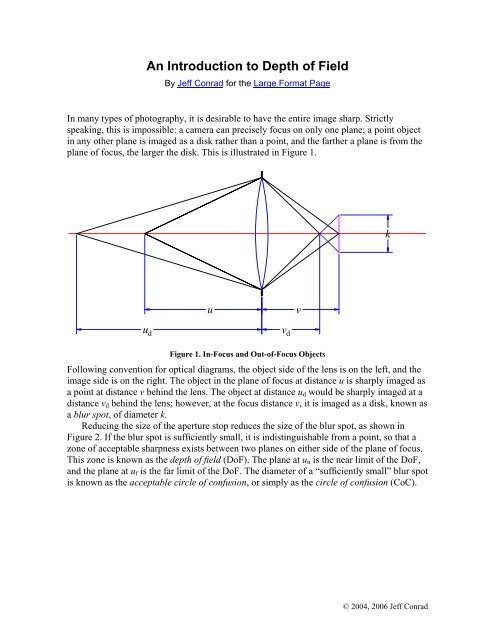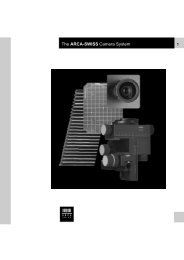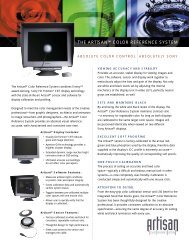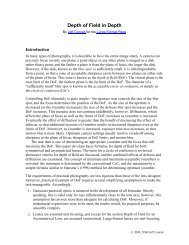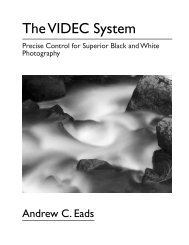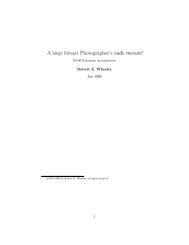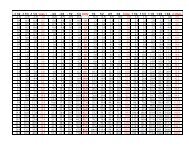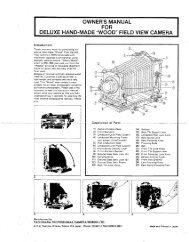Introduction to Depth of Field (PDF) - Large Format Photography. Info
Introduction to Depth of Field (PDF) - Large Format Photography. Info
Introduction to Depth of Field (PDF) - Large Format Photography. Info
Create successful ePaper yourself
Turn your PDF publications into a flip-book with our unique Google optimized e-Paper software.
An <strong>Introduction</strong> <strong>to</strong> <strong>Depth</strong> <strong>of</strong> <strong>Field</strong><br />
By Jeff Conrad for the <strong>Large</strong> <strong>Format</strong> Page<br />
In many types <strong>of</strong> pho<strong>to</strong>graphy, it is desirable <strong>to</strong> have the entire image sharp. Strictly<br />
speaking, this is impossible: a camera can precisely focus on only one plane; a point object<br />
in any other plane is imaged as a disk rather than a point, and the farther a plane is from the<br />
plane <strong>of</strong> focus, the larger the disk. This is illustrated in Figure 1.<br />
k<br />
u<br />
v<br />
u d<br />
v d<br />
Figure 1. In-Focus and Out-<strong>of</strong>-Focus Objects<br />
Following convention for optical diagrams, the object side <strong>of</strong> the lens is on the left, and the<br />
image side is on the right. The object in the plane <strong>of</strong> focus at distance u is sharply imaged as<br />
a point at distance v behind the lens. The object at distance u d would be sharply imaged at a<br />
distance v d behind the lens; however, at the focus distance v, it is imaged as a disk, known as<br />
a blur spot, <strong>of</strong> diameter k.<br />
Reducing the size <strong>of</strong> the aperture s<strong>to</strong>p reduces the size <strong>of</strong> the blur spot, as shown in<br />
Figure 2. If the blur spot is sufficiently small, it is indistinguishable from a point, so that a<br />
zone <strong>of</strong> acceptable sharpness exists between two planes on either side <strong>of</strong> the plane <strong>of</strong> focus.<br />
This zone is known as the depth <strong>of</strong> field (DoF). The plane at u n is the near limit <strong>of</strong> the DoF,<br />
and the plane at u f is the far limit <strong>of</strong> the DoF. The diameter <strong>of</strong> a “sufficiently small” blur spot<br />
is known as the acceptable circle <strong>of</strong> confusion, or simply as the circle <strong>of</strong> confusion (CoC).<br />
© 2004, 2006 Jeff Conrad
An <strong>Introduction</strong> <strong>to</strong> <strong>Depth</strong> <strong>of</strong> <strong>Field</strong> Page 2<br />
DoF<br />
c<br />
u<br />
un<br />
v<br />
u f<br />
Figure 2. <strong>Depth</strong> <strong>of</strong> <strong>Field</strong> and Circle <strong>of</strong> Confusion<br />
The DoF depends on the CoC, the lens focal length, the object distance, and the lens f-<br />
number. To a first approximation, the lens focal length and object distance determine the<br />
image magnification, so that DoF depends on magnification and f-number; lesser<br />
magnification and greater f-number (smaller lens opening) give a greater DoF.<br />
The CoC is somewhat subjective, and depends on several fac<strong>to</strong>rs, including viewing<br />
conditions and required enlargement. Standard assumptions usually are an 8″×10″ final<br />
image viewed at a distance <strong>of</strong> 250 mm, and that a final-image CoC <strong>of</strong> 0.2 mm at that<br />
distance cannot be distinguished from a point. If the original image is smaller than 8″×10″, it<br />
must be enlarged <strong>to</strong> make 8″×10″ final image, and the CoC in the original image is reduced<br />
by the required enlargement. For example, a 4×5 image must be enlarged 2×, so its standard<br />
CoC is 0.1 mm. Although standard values <strong>of</strong>ten are fine, some adjustment may be needed if<br />
the planned viewing conditions differ from those assumed in determining the standard<br />
values. This may be especially true if an 8″×10″ final image will be made from a 35 mm<br />
image, where only a 5× enlargement <strong>of</strong>ten is assumed. Adjustment also may be required if<br />
the pho<strong>to</strong>grapher intends <strong>to</strong> examine large prints at close distances with a magnifying glass.<br />
However, because <strong>of</strong> diffraction, the practical amount <strong>of</strong> adjustment is limited when<br />
substantial DoF is required.<br />
Except for camera movements, there only are two DoF-related tasks: setting the focus<br />
and the lens f-number. This paper concentrates on the few formulae needed <strong>to</strong> accomplish<br />
those tasks; the derivations <strong>of</strong> those formulae and many others are given in Conrad (2006).<br />
© 2004, 2006 Jeff Conrad
An <strong>Introduction</strong> <strong>to</strong> <strong>Depth</strong> <strong>of</strong> <strong>Field</strong> Page 3<br />
DoF<br />
c<br />
u<br />
un<br />
v<br />
u f<br />
Figure 3. Object Distances and DoF<br />
Object-Side Relationships<br />
Object-side relationships can be useful for illustrating DoF concepts, and possibly for handcamera<br />
users working with lens distance scales, although it usually is easier <strong>to</strong> use lens DoF<br />
scales. With a view camera, it nearly always is easier <strong>to</strong> use the image-side relationships,<br />
discussed in the next section.<br />
The relevant quantities are shown in Figure 3. The distances indicated by u x on the left<br />
side are the object distances; the image distance v on the right corresponds <strong>to</strong> the focused<br />
object at distance u.<br />
More <strong>of</strong>ten than not, the pho<strong>to</strong>grapher will choose the limits <strong>of</strong> DoF, and set the focus<br />
and f-number accordingly. To have the DoF between near and far distances u n and u f ,<br />
2× near distance×<br />
far distance<br />
focus =<br />
,<br />
near distance + far distance<br />
or<br />
2unuf<br />
u =<br />
(1)<br />
u + u<br />
The f-number is<br />
N =<br />
n<br />
f<br />
2<br />
f u − u<br />
c u u f u u f<br />
f n<br />
f( n<br />
− ) +<br />
n(<br />
f<br />
− ) , (2)<br />
where N is the f-number, f is the lens focal length, and c is the CoC. The difference u f − u n is<br />
the DoF. This is a bit tedious <strong>to</strong> calculate, but if the near and far limits <strong>of</strong> DoF are large in<br />
comparison with the lens focal length,<br />
© 2004, 2006 Jeff Conrad
An <strong>Introduction</strong> <strong>to</strong> <strong>Depth</strong> <strong>of</strong> <strong>Field</strong> Page 4<br />
or<br />
f-number<br />
≈<br />
N<br />
f<br />
c<br />
u − u<br />
2u u<br />
2<br />
( focal length) × ( far distance −near distance)<br />
CoC× far distance×<br />
near distance<br />
2<br />
f n<br />
≈ (3)<br />
f<br />
n<br />
This still is rather tedious, but as will be seen, Eqs. (1) or (3) hardly ever are necessary.<br />
Eq. (3) is instructive in that it shows the reciprocal relationship between N and c: for<br />
constant DoF, increasing the f-number is equivalent <strong>to</strong> decreasing the CoC by the same<br />
ratio; this can be useful with a hand-camera lens whose DoF scales are based on a CoC that<br />
is not appropriate for the intended viewing conditions. For example, if a 35 mm camera has<br />
DoF scales determined for a CoC <strong>of</strong> 0.035 mm and viewing conditions require a CoC <strong>of</strong><br />
0.025 mm, the smaller CoC can be achieved by using an f-number one step greater than<br />
indicated by the lens DoF scale. Note also that the distance given by Eq. (1) is independent<br />
<strong>of</strong> N: if the f-number is increased <strong>to</strong> decrease the effective CoC, there is no need <strong>to</strong> refocus.<br />
When the far limit <strong>of</strong> DoF is infinity, and the f-number is fixed (possibly because <strong>of</strong><br />
motion blur considerations), the focus distance is<br />
2<br />
f<br />
uh<br />
= + f (4)<br />
Nc<br />
The distance u h is called the hyperfocal distance. At the hyperfocal distance, a difference <strong>of</strong><br />
one focal length is insignificant, so Eq. (4) <strong>of</strong>ten is given simply as<br />
or<br />
( focal length) 2<br />
hyperfocal distance ≈<br />
,<br />
f-number × CoC<br />
2<br />
f<br />
uh<br />
≈ (5)<br />
Nc<br />
When the focus is set <strong>to</strong> the hyperfocal distance, the near limit <strong>of</strong> DoF is half the hyperfocal<br />
distance, or<br />
u<br />
u f<br />
2 2Nc<br />
2<br />
h<br />
n<br />
= ≈ , (6)<br />
so the DoF extends from half the hyperfocal distance <strong>to</strong> infinity. If the near limit <strong>of</strong> DoF is<br />
fixed,<br />
focus = 2× near distance ,<br />
or<br />
u = 2u<br />
; (7)<br />
the f-number is<br />
n<br />
( focal length) 2<br />
f-number<br />
≈ ,<br />
2 × CoC × near distance<br />
,<br />
© 2004, 2006 Jeff Conrad
An <strong>Introduction</strong> <strong>to</strong> <strong>Depth</strong> <strong>of</strong> <strong>Field</strong> Page 5<br />
or<br />
2<br />
f<br />
N ≈ (8)<br />
2cu<br />
n<br />
The near:far ratio <strong>of</strong> the DoF is<br />
or<br />
near DoF near distance<br />
= ,<br />
far DoF far distance<br />
u−<br />
un<br />
un =<br />
(9)<br />
u − u u<br />
f<br />
f<br />
Except when the near and far limits <strong>of</strong> DoF coincide, the focus point always is closer <strong>to</strong> the<br />
near limit. Despite long-standing legend, the near-<strong>to</strong>-<strong>to</strong>tal ratio is ⅓ only when u f = 2u n , so<br />
that the “rule” <strong>to</strong> focus ⅓ <strong>of</strong> the way in<strong>to</strong> a scene hardly ever is valid.<br />
In practice, it seldom is necessary <strong>to</strong> make any <strong>of</strong> these calculations. With a manualfocus<br />
hand camera whose lens includes a DoF scale, the settings can be made using that<br />
scale. With view camera, the required settings can be determined on the image side, where<br />
the calculations are much simpler. Unfortunately, controlling DoF with an au<strong>to</strong>focus hand<br />
camera usually is quite difficult with or without calculations.<br />
Δv<br />
c<br />
u<br />
un<br />
v f<br />
v<br />
u f<br />
vn<br />
Figure 4. Image Distances and Focus Spread<br />
Image-Side Relationships<br />
In practice, camera settings usually are determined using image distances, whether directly<br />
in the case <strong>of</strong> a view camera, or by using distance and DoF scales on hand-camera lenses.<br />
The procedure with a view camera is quite simple: focus on the near object, and note the<br />
position <strong>of</strong> the standard; focus on the far object, and again note the position <strong>of</strong> the standard.<br />
© 2004, 2006 Jeff Conrad
An <strong>Introduction</strong> <strong>to</strong> <strong>Depth</strong> <strong>of</strong> <strong>Field</strong> Page 6<br />
The relevant distances are shown in Figure 4: the image distances v n and v f are the positions<br />
<strong>of</strong> the standard when focused on the near and far objects, respectively; they correspond <strong>to</strong><br />
object distances u n and u f . The difference v n − v f between the two positions <strong>of</strong> the standard is<br />
the focus spread Δv.<br />
In most cases,<br />
focus spread<br />
focus ≈ image distance <strong>of</strong> far object + ,<br />
2<br />
or<br />
Δv<br />
v≈ vf<br />
+ ; (10)<br />
2<br />
Focus is set <strong>to</strong> halfway between the near and far positions <strong>of</strong> the standard; it does not appear<br />
quite that way in Figure 4 because the focus spread is greatly exaggerated. When the focus<br />
spread is reasonably small, the f-number is<br />
1 Δv<br />
N ≈ , (11)<br />
1 + m 2c<br />
where m is the magnification <strong>of</strong> the focused object. Except at close working distances, m is<br />
small, and Eq. (11) <strong>of</strong>ten can be simplified <strong>to</strong><br />
focus spread<br />
f-number<br />
≈<br />
,<br />
2×<br />
CoC<br />
or<br />
Δv<br />
N ≈ (12)<br />
2c<br />
Note again the reciprocal relationship between N and c in Eqs. (11) and (12); for a given<br />
focus spread, using a greater f-number is equivalent <strong>to</strong> using a smaller CoC.<br />
Eqs. (10) and (12) also apply if swings or tilts have been set. Some view cameras, such<br />
as those by Sinar, incorporate mechanical focus and DoF calcula<strong>to</strong>rs, so that no manual<br />
calculations are needed.<br />
If the camera does not include a DoF calcula<strong>to</strong>r, measurement <strong>of</strong> focus spread is much<br />
easier if the bed or focusing rail includes a scale, and measurements can be more precise if<br />
the focusing knob includes an additional scale. See Hayashi for a description <strong>of</strong> adding a<br />
Sinar-type DoF scale <strong>to</strong> the focusing knob, and Evens (2003) for a discussion <strong>of</strong> adding<br />
scales <strong>to</strong> both the rail and the knob.<br />
Equations (10) and (12) are the basis for most hand-camera lens DoF scales, even<br />
though the scales indicate <strong>to</strong> subject-<strong>to</strong>-image distance. These equations also appear <strong>to</strong> have<br />
been the basis for Canon’s <strong>Depth</strong>-<strong>of</strong>-<strong>Field</strong> AE mode, which, lamentably, was discontinued<br />
on models introduced after early 2004.<br />
Maximum f-Number<br />
The f-number given by Eq. (12) is the minimum that will give the specified sharpness at the<br />
limits <strong>of</strong> DoF. In many cases, sharpness at the DoF limits can be improved by using a<br />
greater f-number, although not without consequence: except with controlled lighting, a<br />
greater f-number requires a longer exposure, which eventually can result in motion blur.<br />
© 2004, 2006 Jeff Conrad
An <strong>Introduction</strong> <strong>to</strong> <strong>Depth</strong> <strong>of</strong> <strong>Field</strong> Page 7<br />
Moreover, the benefit <strong>of</strong> less blur from defocus eventually is <strong>of</strong>fset by diffraction, the<br />
bending <strong>of</strong> light as it passes through an aperture, causing the light <strong>to</strong> spread slightly and<br />
produce a s<strong>of</strong>ter image. Diffraction increases as the f-number is increased; it is unavoidable<br />
with any lens <strong>of</strong> any design, and affects the center <strong>of</strong> the image as well as the limits <strong>of</strong> DoF.<br />
Once the effect <strong>of</strong> diffraction equals that from defocus, any additional increase in f-number<br />
will result in less sharpness at the limits <strong>of</strong> DoF as well as at the plane <strong>of</strong> focus. For practical<br />
purposes, that limit can be given as 1<br />
or<br />
maximum f -number = 400× focus spread ,<br />
N<br />
max<br />
= 400Δv , (13)<br />
where Δv is the focus spread in mm. For most reasonable values <strong>of</strong> focus spread, the f-<br />
number given by Eq. (13) is greater than that given by Eq. (12), so Eqs. (12) and (13) can be<br />
regarded as limits for an acceptable range <strong>of</strong> f-numbers. In many cases, considerations <strong>of</strong><br />
motion blur will determine the selection the f-number within the acceptable range. For<br />
example, for a 4×5 camera, the standard CoC is 0.1 mm; with a 4 mm focus spread, the<br />
conventional f-number from Eq. (12) is<br />
4<br />
N = = 20<br />
2×<br />
0.1<br />
The maximum f-number from Eq. (13) is<br />
N<br />
max<br />
= 400× 4 = 40 ,<br />
so the actual f-number should be somewhere between 20 and 40.<br />
The f-number from Eq. (13) is the optimum value for the DoF limits, but it may not be<br />
optimal for the entire image. Most large-format lenses are sharpest between f/16 and f/22,<br />
and increasing the f-number beyond this always reduces sharpness for objects in the plane <strong>of</strong><br />
focus. In many cases, reasonably uniform sharpness throughout the image is preferable <strong>to</strong><br />
optimal sharpness in the plane <strong>of</strong> focus, but the decision may depend on the individual<br />
image, and ultimately, is an aesthetic judgment that must be made by the pho<strong>to</strong>grapher.<br />
Using an f-number greater than that given by Eq. (13) never increases sharpness. It can be<br />
argued that if the blur is less than the threshold <strong>of</strong> detection, any increase in sharpness is<br />
irrelevant; however, having the greatest possible sharpness can be useful if at some time it is<br />
decided <strong>to</strong> make a larger final image than originally planned.<br />
Minimum and Maximum f-Numbers on Hand-Camera Lenses<br />
With a hand camera, focus spread usually is difficult <strong>to</strong> measure, but if the lens<br />
manufacturer’s CoC is known, the maximum f-number can be determined from the f-number<br />
marked on the lens as follows:<br />
maximum f-number = 800× CoC×<br />
marked f-number<br />
1 The basis for Eq. (13) is given in Conrad (2006). Using considerably different methods, Hansma (1996)<br />
developed a nearly identical formula: N = 375 Δ v .<br />
opt<br />
© 2004, 2006 Jeff Conrad
An <strong>Introduction</strong> <strong>to</strong> <strong>Depth</strong> <strong>of</strong> <strong>Field</strong> Page 8<br />
If the CoC used <strong>to</strong> determine the len’s marked f-numbers is not appropriate for the intended<br />
viewing conditions, appropriate minimum f-numbers as well as maximum f-numbers must<br />
be calculated. For example, if a 35 mm camera lens’s marked f-numbers are based on a<br />
0.035 mm CoC, and the intended conditions require a CoC <strong>of</strong> 0.025 mm, the appropriate<br />
minimum f-numbers are approximately one exposure step greater than those marked. The<br />
maximum f-numbers then are determined from<br />
maximum f-number = 28×<br />
marked f-number<br />
The results are shown in Table 1; all values are rounded <strong>to</strong> the nearest ⅓ step.<br />
Table 1. Marked, Minimum, and Maximum f-Numbers<br />
N 0.035 N 0.025 N max<br />
1.4 2 6.3<br />
2 2.8 7.1<br />
2.8 4 9<br />
4 5.6 10<br />
5.6 8 13<br />
8 11 14<br />
11 16 18<br />
16 (22) 20<br />
22 (32) 25<br />
(32) (45) 29<br />
The subscripts in the first two column headings indicate the CoC used in determining the f-<br />
numbers. The marked f-numbers, based on a 0.035 mm CoC, are shown in the first column.<br />
The minimum f-numbers, based on a 0.025 mm CoC, are shown in the second column, and<br />
the maximum f-numbers are in the last column. The f-numbers in parentheses, beginning<br />
with 32 in the first column and 22 in the second column, are greater than the maximum f-<br />
numbers; when DoF measurements indicate an f-number in parentheses, the maximum f-<br />
number should be used instead. Eq. (13) is independent <strong>of</strong> focal length, so the third column<br />
<strong>of</strong> Table 1 is valid for any lens based on the same CoC.<br />
For example, if measurements indicated a required f-number <strong>of</strong> 5.6 on the lens DoF<br />
scale, the minimum f-number would be 8, and the maximum would be 13, so the range <strong>of</strong><br />
acceptable f-numbers would be from 8 <strong>to</strong> 13. If the indicated f-number were 16, the<br />
minimum f-number would be 22 and the maximum would be 20; accordingly, the maximum<br />
should be used. When the minimum f-number is greater than the maximum, the blur spot<br />
will be larger than that specified by the 0.025 mm CoC. It simply is not always possible <strong>to</strong><br />
achieve the desired sharpness when great DoF is required.<br />
If the lens manufacturer’s CoC is not known, it <strong>of</strong>ten can be estimated from the lens<br />
distance and DoF scales by setting the infinity mark on the distance scale opposite the<br />
greatest marked f-number on the DoF scale; the focus index mark then is at the hyperfocal<br />
distance. Solving Eq. (4) for c gives<br />
f<br />
c =<br />
N u<br />
2<br />
( − f )<br />
h<br />
© 2004, 2006 Jeff Conrad
An <strong>Introduction</strong> <strong>to</strong> <strong>Depth</strong> <strong>of</strong> <strong>Field</strong> Page 9<br />
Lens distance scales usually indicate object-<strong>to</strong>-image distance. At the hyperfocal distance,<br />
the indicated distance can be taken as the object distance + focal length with minimal error;<br />
if x h is the indicated hyperfocal distance,<br />
or<br />
2<br />
( focal length)<br />
( )<br />
CoC ≈<br />
f-number × indicated distance − 2×<br />
focal length<br />
f<br />
c ≈<br />
N x<br />
References<br />
2<br />
( − f )<br />
h<br />
2<br />
Conrad, Jeff. 2006. <strong>Depth</strong> <strong>of</strong> <strong>Field</strong> in <strong>Depth</strong>. Available in <strong>PDF</strong> at<br />
http://www.largeformatpho<strong>to</strong>graphy.info/.<br />
Evens, Leonard. 2003. Some Thoughts on View Camera Calculations. Available in <strong>PDF</strong> at<br />
math.northwestern.edu/~len/pho<strong>to</strong>s/pages/d<strong>of</strong>_essay.pdf.<br />
Hansma, Paul K. 1996. “View Camera Focusing in Practice,” Pho<strong>to</strong> Techniques,<br />
March/April 1996, 54–57. Available in <strong>PDF</strong> at<br />
http://www.largeformatpho<strong>to</strong>graphy.info/.<br />
Hayashi, Masayoshi. Making a DOF calcula<strong>to</strong>r for your camera.<br />
http://www.largeformatpho<strong>to</strong>graphy.info/d<strong>of</strong>knob/.<br />
,<br />
(14)<br />
© 2004, 2006 Jeff Conrad


